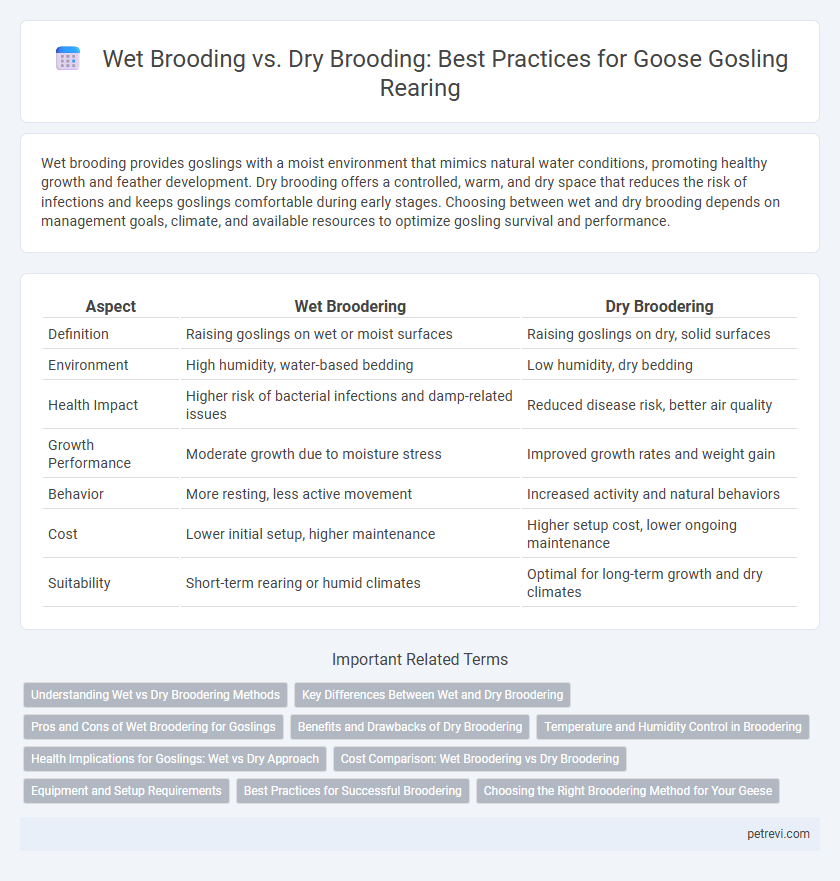Wet brooding provides goslings with a moist environment that mimics natural water conditions, promoting healthy growth and feather development. Dry brooding offers a controlled, warm, and dry space that reduces the risk of infections and keeps goslings comfortable during early stages. Choosing between wet and dry brooding depends on management goals, climate, and available resources to optimize gosling survival and performance.
Table of Comparison
| Aspect | Wet Broodering | Dry Broodering |
|---|---|---|
| Definition | Raising goslings on wet or moist surfaces | Raising goslings on dry, solid surfaces |
| Environment | High humidity, water-based bedding | Low humidity, dry bedding |
| Health Impact | Higher risk of bacterial infections and damp-related issues | Reduced disease risk, better air quality |
| Growth Performance | Moderate growth due to moisture stress | Improved growth rates and weight gain |
| Behavior | More resting, less active movement | Increased activity and natural behaviors |
| Cost | Lower initial setup, higher maintenance | Higher setup cost, lower ongoing maintenance |
| Suitability | Short-term rearing or humid climates | Optimal for long-term growth and dry climates |
Understanding Wet vs Dry Broodering Methods
Wet brooder systems for goose gosling rearing involve maintaining a warm, moist environment that mimics natural conditions, reducing heat stress and encouraging healthy growth. Dry brooder methods provide a controlled, dry heat source with bedding materials to promote hygiene and prevent respiratory issues. Selecting the appropriate brooding technique depends on factors such as climate, flock size, and disease management practices to optimize gosling survival and development.
Key Differences Between Wet and Dry Broodering
Wet brooder systems for goose goslings use water or damp bedding to maintain humidity, promoting skin hydration and reducing dust, which can lower respiratory issues. Dry brooder setups rely on dry litter or materials to keep the environment warm and clean, minimizing microbial growth and preventing footpad injuries. Key differences include moisture control, disease risk, and comfort, with wet brooders favoring hydration and dry brooders focusing on dryness and hygiene.
Pros and Cons of Wet Broodering for Goslings
Wet broodering for goose goslings offers benefits such as enhanced humidity control and easier temperature regulation, promoting healthy feather development and reducing dehydration risk. However, it can increase the risk of bacterial infections and requires diligent sanitation to prevent disease outbreaks. The moist environment may also lead to higher maintenance efforts and potential leg issues due to prolonged exposure to wet surfaces.
Benefits and Drawbacks of Dry Broodering
Dry broodering for goose gosling rearing offers benefits such as reduced risk of wet-related diseases, improved hygiene, and easier temperature control, leading to healthier growth conditions. However, drawbacks include the need for increased vigilance to maintain adequate humidity levels, potential stress from lack of water access for natural behaviors, and the requirement for more equipment like heat lamps and dry bedding maintenance. Optimal dry broodering balances these factors to promote gosling welfare and efficient farm management.
Temperature and Humidity Control in Broodering
Wet brooding for goose gosling rearing maintains higher humidity levels around 60-70% and temperatures ranging from 32-35degC during the first week to support hydration and reduce heat stress. Dry brooding requires strict temperature management between 35-38degC with lower humidity levels near 40-50% to prevent respiratory issues and maintain dry bedding for gosling health. Effective temperature and humidity control in either method optimizes gosling growth, feather development, and overall survival rates.
Health Implications for Goslings: Wet vs Dry Approach
Wet brooding for goose goslings involves providing a moist environment that can enhance hydration but may increase the risk of bacterial infections and respiratory issues due to high humidity and damp bedding. Dry brooding, characterized by maintaining a warm, dry, and well-ventilated area, tends to reduce the incidence of fungal growth and pathogens, promoting stronger immune development and lower mortality rates. Health outcomes for goslings are generally more favorable with dry brooding, as it supports better thermoregulation and reduces exposure to harmful microorganisms.
Cost Comparison: Wet Broodering vs Dry Broodering
Wet broodering for goose gosling rearing typically incurs higher costs due to increased expenses for water management, humidity control, and bedding replacement. Dry broodering tends to be more cost-effective, minimizing water usage and associated maintenance while reducing feed spoilage and disease risks. Cost comparisons show dry broodering can reduce overall operational expenses by up to 20%, making it a preferred choice for budget-conscious producers.
Equipment and Setup Requirements
Wet broodering requires waterproof brooders equipped with heating lamps, adequate drainage, and moisture-resistant flooring to maintain optimal humidity levels for gosling comfort and health. Dry broodering setups focus on insulated, draft-free enclosures with dry bedding materials such as straw or wood shavings, along with regulated heat sources like radiant heaters to prevent dampness and reduce disease risks. Proper ventilation systems and adjustable temperature controls are essential in both methods to ensure stable environments conducive to gosling growth.
Best Practices for Successful Broodering
Wet brooding for goose goslings involves maintaining a consistently damp or moist environment, promoting better hydration and reducing dust-related respiratory issues, but requires vigilant temperature and hygiene control to prevent infections. Dry brooding, using dry litter and controlled humidity, minimizes moisture-related diseases and supports natural behaviors like scratching, enhancing gosling growth and comfort. Optimal goose rearing combines regulated temperature, clean bedding, adequate ventilation, and monitoring gosling behavior to ensure healthy development and reduce mortality rates.
Choosing the Right Broodering Method for Your Geese
Choosing the right broodering method for goose gosling rearing significantly impacts growth rates and health outcomes. Wet brooding provides higher humidity and warmth, promoting better skin hydration and reducing respiratory issues, while dry brooding offers drier conditions minimizing the risk of infections and footpad lesions. Evaluating environmental factors, flock size, and disease prevalence will guide optimal broodering decisions to enhance gosling survival and performance.
Wet Broodering vs Dry Broodering for Goose Gosling Rearing Infographic

 petrevi.com
petrevi.com